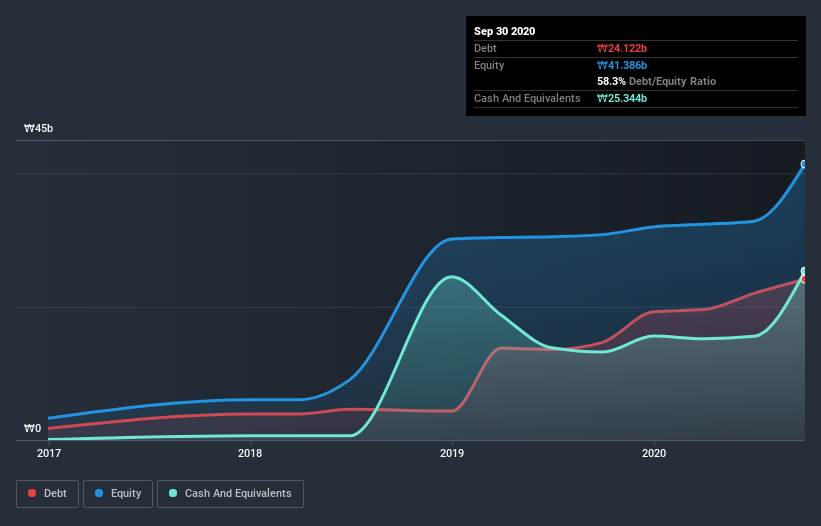
Some say volatility, rather than debt, is the best way to think about risk as an investor, but Warren Buffett famously said that 'Volatility is far from synonymous with risk.' When we think about how risky a company is, we always like to look at its use of debt, since debt overload can lead to ruin. We can see that S-Fuelcell co., Ltd. (KOSDAQ:288620) does use debt in its business. But is this debt a concern to shareholders?
What Risk Does Debt Bring?
Debt assists a business until the business has trouble paying it off, either with new capital or with free cash flow. Ultimately, if the company can't fulfill its legal obligations to repay debt, shareholders could walk away with nothing. However, a more frequent (but still costly) occurrence is where a company must issue shares at bargain-basement prices, permanently diluting shareholders, just to shore up its balance sheet. Having said that, the most common situation is where a company manages its debt reasonably well - and to its own advantage. When we examine debt levels, we first consider both cash and debt levels, together.
Check out our latest analysis for S-Fuelcell
How Much Debt Does S-Fuelcell Carry?
You can click the graphic below for the historical numbers, but it shows that as of September 2020 S-Fuelcell had ₩24.1b of debt, an increase on ₩14.7b, over one year. But on the other hand it also has ₩25.3b in cash, leading to a ₩1.22b net cash position.

How Strong Is S-Fuelcell's Balance Sheet?
According to the last reported balance sheet, S-Fuelcell had liabilities of ₩43.0b due within 12 months, and liabilities of ₩5.22b due beyond 12 months. Offsetting these obligations, it had cash of ₩25.3b as well as receivables valued at ₩29.5b due within 12 months. So it actually has ₩6.64b more liquid assets than total liabilities.
This surplus suggests that S-Fuelcell has a conservative balance sheet, and could probably eliminate its debt without much difficulty. Simply put, the fact that S-Fuelcell has more cash than debt is arguably a good indication that it can manage its debt safely.
Better yet, S-Fuelcell grew its EBIT by 324% last year, which is an impressive improvement. That boost will make it even easier to pay down debt going forward. The balance sheet is clearly the area to focus on when you are analysing debt. But it is S-Fuelcell's earnings that will influence how the balance sheet holds up in the future. So if you're keen to discover more about its earnings, it might be worth checking out this graph of its long term earnings trend.
Finally, while the tax-man may adore accounting profits, lenders only accept cold hard cash. While S-Fuelcell has net cash on its balance sheet, it's still worth taking a look at its ability to convert earnings before interest and tax (EBIT) to free cash flow, to help us understand how quickly it is building (or eroding) that cash balance. During the last three years, S-Fuelcell burned a lot of cash. While investors are no doubt expecting a reversal of that situation in due course, it clearly does mean its use of debt is more risky.
Summing up
While it is always sensible to investigate a company's debt, in this case S-Fuelcell has ₩1.22b in net cash and a decent-looking balance sheet. And it impressed us with its EBIT growth of 324% over the last year. So we are not troubled with S-Fuelcell's debt use. When analysing debt levels, the balance sheet is the obvious place to start. But ultimately, every company can contain risks that exist outside of the balance sheet. Case in point: We've spotted 4 warning signs for S-Fuelcell you should be aware of, and 3 of them are potentially serious.
At the end of the day, it's often better to focus on companies that are free from net debt. You can access our special list of such companies (all with a track record of profit growth). It's free.
If you decide to trade S-Fuelcell, use the lowest-cost* platform that is rated #1 Overall by Barron’s, Interactive Brokers. Trade stocks, options, futures, forex, bonds and funds on 135 markets, all from a single integrated account. Promoted
New: Manage All Your Stock Portfolios in One Place
We've created the ultimate portfolio companion for stock investors, and it's free.
• Connect an unlimited number of Portfolios and see your total in one currency
• Be alerted to new Warning Signs or Risks via email or mobile
• Track the Fair Value of your stocks
This article by Simply Wall St is general in nature. It does not constitute a recommendation to buy or sell any stock, and does not take account of your objectives, or your financial situation. We aim to bring you long-term focused analysis driven by fundamental data. Note that our analysis may not factor in the latest price-sensitive company announcements or qualitative material. Simply Wall St has no position in any stocks mentioned.
*Interactive Brokers Rated Lowest Cost Broker by StockBrokers.com Annual Online Review 2020
Have feedback on this article? Concerned about the content? Get in touch with us directly. Alternatively, email editorial-team@simplywallst.com.
About KOSDAQ:A288620
S-Fuelcell
S-Fuelcell Co., Ltd. provides fuel cell systems, hydrogen generation systems, and fuel conversion devices.
Adequate balance sheet very low.
Market Insights
Community Narratives




